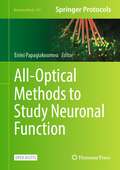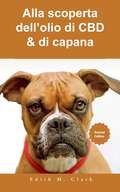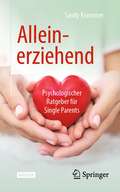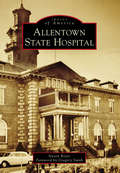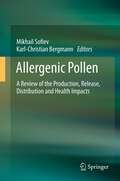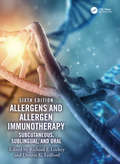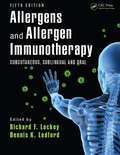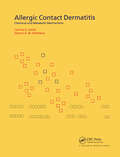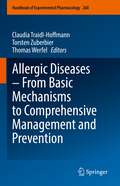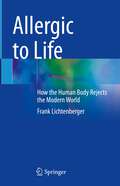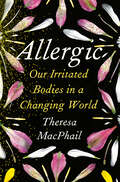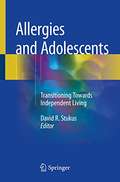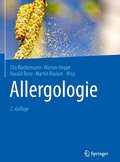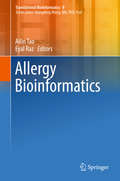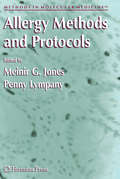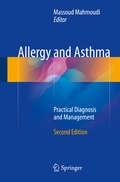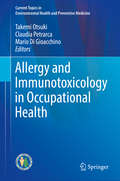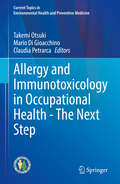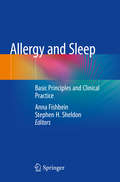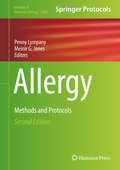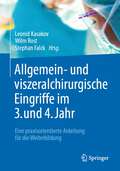- Table View
- List View
All-Optical Methods to Study Neuronal Function (Neuromethods #191)
by Eirini PapagiakoumouThis open access volume provides an overview of the latest methods used to study neuronal function with all-optical experimental approaches, where light is used for both stimulation and monitoring of neuronal activity. The chapters in this book cover topics over a broad range, from fundamental background information in both physiology and optics in the context of all-optical neurophysiology experiments, to the design principles and hardware implementation of optical methods used for photoactivation and imaging. In the Neuromethods series style, chapters include the kind of detail and key advice from the specialists needed to get successful results in your laboratory. Comprehensive and cutting-edge, All-Optical Methods to Study Neuronal Function is a valuable resource for researchers in various disciplines such as physics, engineering, and neuroscience. This book will serve as a guide to establish useful references for groups starting out in this field, and provide insight on the optical systems, actuators, and sensors. This is an open access book.
Alla scoperta dell’olio di CBD & di capana
by Edith M. ClarkQuesto libro è inteso come guida per apprendere qualcosa sull'olio di CBD e di canapa. L'olio di CBD è efficace contro il dolore, l'epilessia, le infiammazioni, l'ansia. Molti studi suggeriscono che l'olio naturale di canapa può apportare benefici contro infiammazioni, dolore generalizzato, nausea. Ecco cosa imparerai: OLIO DI CBD: COSA NON SAPEVI AL RIGUARDO IL CBD NON E' PSICOATTIVO L'OLIO DI CBD RIDUCE L'ANSIA IL CBD POTREBBE CONTRIBUIRE ALLA LOTTA AL CANCRO IL CBD HA EFFETTO SUGLI ATTACCI EPILETTICI IL CBD HA FUNZIONE ANTIDOLORIFICA IL CBD PUO' AIUTARE CONTRO INFIAMMAZIONI DELL'APPARATO GASTROINTESTINALE IL CBD RIDUCE L'EFFETTO DI INFIAMMAZIONI CRONICHE IL CBD PUO' PROTEGGERE IL SISTEMA NERVOSO IL CBD AUMENTA L'APPETITO E COMBATTE LA NAUSEA IL CBD PROMUOVE LA SALUTE CARDIOVASCOLARE
Alleinerziehend: Psychologischer Ratgeber für Single Parents
by Sandy KrammerDieser Selbsthilfe-Ratgeber ist für Alleinerziehende geschrieben. Auf deren Schultern lastet das Gewicht einer ganzen Welt: die Welt eines oder mehrerer Kinder. Besonders dann, wenn Kinder involviert sind, stellt eine Trennung oder Scheidung vieles auf den Kopf. Oft bleibt kein Stein auf dem anderen. Veränderungen sind vielfältig und die Anspannung ist oft groß. Lang andauernde psychische Belastungen, Konflikte und weitere Schwierigkeiten können zu einer bedrückten Stimmung und zu Erschöpfungszuständen führen. Die Gesundheit der Eltern kann diejenige der Kinder beeinflussen. In diesem Ratgeber lesen Sie psychologische Hintergrund-Informationen, Fallbeispiele, Übungen und Geschichten. Ziel ist es, allein Erziehenden neue Wege aufzuzeigen, das eigene Wohl zu steigern und dadurch auch das ihrer Kinder. Dieses Buch ist ein Psychotherapeut für das Sofa daheim. Aus dem Inhalt: Trennung – Bedürfnisse, Gefühle, Denken, Verhalten – psychische Gesundheit – Körper und Wohlbefinden – Soziales und Gemeinschaft – Perspektiven finden. Über die Autorin: Dr. phil. Sandy Krammer, LL.M., ist promovierte Psychologin FSP und systemische Beraterin. Sie arbeitet vor allem im Bereich Familien, Psychosomatik und Stressbewältigung. Es ist ihr ein Anliegen, ihre Erfahrungen in einem Buch zur Verfügung zu stellen. Dabei kann sie auf ihr profundes Fachwissen sowie auf eigene Erfahrungen als allein Erziehende zurückgreifen.
Allentown State Hospital (Images of America)
by Steven RoyerAllentown State Hospital, formerly known as the Homoeopathic State Hospital for the Insane at Allentown, was the first homeopathic state hospital for the treatment of the mentally ill in Pennsylvania. On October 3, 1912, under the direction of its superintendent, Dr. Henry I. Klopp, the hospital opened its doors to receiving patients. In 1930, Dr. Klopp opened a children's ward on the hospital's grounds, one of the first of its kind in the world. Built to alleviate overcrowding in the state mental health system, the hospital quickly exceeded its own occupancy. By 1954, the population of the hospital hit its peak of 2,107 patients. However, Allentown State Hospital would consistently pioneer change in the mental health system until its closure in 2010. In 1993, a dedicated group of employees created the Psychiatric Emergency Response Team (PERT) process to provide a safer response to supporting patients in crisis. By 1998, this approach helped put the spotlight on Allentown State Hospital when it became the first hospital in the United States to go seclusion free.
Allergenic Pollen: A Review of the Production, Release, Distribution and Health Impacts
by Mikhail Sofiev Karl-Christian BergmannThis is the first book to summarize all aspects of allergenic pollen: production, atmospheric distribution, and health impacts, as well as the means of monitoring and forecasting these phenomena. Based on a four-year effort by a large group of leading European scientists, this book highlights the new developments in research on allergenic pollen, including the modelling prospects and effects of climate change. The multidisciplinary team of authors offers insights into the latest technology of detection of pollen and its allergenic properties, forecasting methods, and the influence of allergenic pollen on the population. The comprehensive coverage in this book makes it an indispensible volume for anyone dealing with allergenic pollen worldwide. Readers involved in environmental health, aerobiology, medicine, and plant science will find this book of interest.
Allergens and Airway Hyperreactivity (Advances in Experimental Medicine and Biology #838)
by Mieczyslaw PokorskiRespiratory allergy is constantly encountered and is sharply on the rise, particularly in the two most vulnerable age-groups: young children and seniors. Allergy results in airway hyperactivity and increased airway resistance, with all inflammatory sequelae being ensued. The chapters show how respiratory allergy research is interconnected with other disciplines by discussing neurotransmitter, membrane receptor, and ionic channel mechanisms of allergy and by giving diagnostic and pharmacological cues on desensitization and therapy.
Allergens and Allergen Immunotherapy: Subcutaneous, Sublingual, and Oral
by Richard F. LockeyThe sixth edition of Lockey and Ledford's Allergens and Allergen Immunotherapy continues to provide comprehensive coverage of all types of allergens and allergen vaccines, providing clinicians the essential information they need to accurately diagnose and manage all allergic conditions. With new and updated chapters, the sixth edition is the most up-to-date, single resource on allergy and immunotherapy. Key Features Completely revised and updated Detailed single source reference on allergy and immunotherapy Reorganized to provide clinicians with essential information to make diagnoses and offer the best treatments
Allergens and Allergen Immunotherapy: Subcutaneous, Sublingual, and Oral, Fifth Edition (Clinical Allergy And Immunology Ser. #Vol. 21)
by Dennis Ledford Richard LockeyThis fifth edition of the bestselling Allergens and Allergen Immunotherapy is now completely updated and revised to include subcutaneous, sublingual, and oral immunomodulator treatments of allergic disease.The redesigned book continues to provide comprehensive coverage of all types of allergens and allergen vaccines, giving clinicians the essential
Allergic Contact Dermatitis: Chemical and Metabolic Mechanisms
by Camilla Smithllergic Contact Dermatitis assesses the potential effects of xenobiotic metabolism and protein reactivity on toxicity. It reviews current knowledge of percutaneous absorption and skin metabolism and includes discussion of the xenobiotics themselves. It answers questions such as: How does sensitisation relate to protein reactivity and levels of metabolism? How we can identify potential hazards in food, cosmetics and pharmaceuticals etc? In a world where people are becoming increasingly aware of their allergies, this up to date one-stop reference will prove an invaluable addition to the shelves of any researcher in academia, government, regulatory bodies, public health officials and, of course, the food, cosmetics and pharmaceuticals industries will find the book to be of particular relevance.
Allergic Diseases – From Basic Mechanisms to Comprehensive Management and Prevention (Handbook of Experimental Pharmacology #268)
by Torsten Zuberbier Thomas Werfel Claudia Traidl-HoffmannAllergy is the most frequent chronic disease in the 21st century having severe negative effects on health and the economy. The challenge we therefore face in medicine and science incorporates all areas of society – from politics to food industry, from schools to city planning, and many more. This volume informs the reader about continuously ongoing developments in allergy research and their implications for society. The chapter sections cover the immunological mechanisms in allergy on a molecular level, describe the triggers and cures for allergy in detail, entail clinical translation of lab findings on allergens, evaluate diagnostics for allergy markers, and provide solutions for future medical intervention or preventive strategies. Laboratory research, bioinformatics, climate modelling, patient treatment, intervention studies, epigenetics and multiple other disciplines are able to shed new light on this revolutionary field of healthcare.
Allergic to Life: How the Human Body Rejects the Modern World
by Frank LichtenbergerThis easy-to-read title provides a comprehensive discussion of the major changes in daily life that have led to states of increased bodily inflammation. Indeed, today there is an epidemic of allergic and autoimmune disease in the first and developing world. While outdoor climate change is now considered common knowledge, the impact of longer work hours, artificial lighting, increased food shelf life, and changes to the microbiome all have made a large impact in increasing allergies worldwide. An allergy, best defined as a “damaging response from the Immune system due to a substance in the environment,” starts with warning signals, or generalized "symptoms," that are caused by something in the environment. Itching, aches, pains, swelling, coughing, and fatigue are all immune responses. Written in an engaging -- and often humorous -- style by an allergist/immunologist, the first three chapters outline how the human body is in an unquestionably harmful environment, and that, in general, the immune system is just doing its job. In subsequent chapters, the specific topics contributing to allergies are covered in detail, starting with microorganisms and a focus on indoor living. Dust mites, for example, are addressed in one full chapter -- and for good reason. The past few decades have seen an explosion of climate controlled, humidified indoor airspace that is ideally suited for more mass production of mites.In the end, emphasizes the author, all roads of inflammation from the environment lead to the “mast cell compartment.” The stress responses of the body summarily drive up this compartment and have led to a world-wide prevalence of between 14% to 17% of “mast cell activation syndrome.” While genetics and comorbid conditions are important in any symptom or disease process, the mast cell compartment feeds and grows off all the major environmental changes of the past 50 or so years. This is why the human body in the 21st century is in a low level state of “rejection,” of the world, says the author. Most of these changes are irreversible, but the situation is not hopeless. Understanding how the body changes itself in response to its environment will allow controlled desensitization to the environment. Allergic to Life: How the Human Body Rejects the Modern World serves as a concise and lively text for clinicians and general readers interested in a deep, expert dive into the world of allergy and immunology.
Allergic: Our Irritated Bodies in a Changing World
by Theresa MacPhailAn &“important and deeply researched&” (The Wall Street Journal) exploration of allergies, from their first medical description in 1819 to the cutting-edge science that is illuminating the changes in our environment and lifestyles that are making so many of us sickHay fever. Peanut allergies. Eczema. Either you have an allergy or you know someone who does. Billions of people worldwide—an estimated 30 to 40 percent of the global population—have some form of allergy. Even more concerning, over the last decade the number of people diagnosed with an allergy has been steadily increasing, placing an ever-growing medical burden on individuals, families, communities, and healthcare systems.Medical anthropologist Theresa MacPhail, herself an allergy sufferer whose father died of a beesting, set out to understand why. In pursuit of answers, MacPhail studied the dangerous experiments of early immunologists as well as the mind-bending recent development of biologics and immunotherapies that are giving the most severely impacted patients hope. She scaled a roof with an air-quality controller who diligently counts pollen by hand for hours every day; met a mother who struggled to use WIC benefits for her daughter with severe food allergies; spoke with doctors at some of the finest allergy clinics in the world; and discussed the intersecting problems of climate change, pollution, and pollen with biologists who study seasonal respiratory allergies.This is the story of allergies: what they are, why we have them, and what that might mean about the fate of humanity in a rapidly changing world.
Allergieprävention: Moderne Strategien der Allergieforschung im Dialog mit der TCM
by Karin StockertIn naher Zukunft wird die Hälfte der Menschheit an Allergien leiden. Dieses Buch präsentiert präventive Strategien unter Berücksichtigung aktueller Mikrobiom-Forschung und der bisher noch wenig diskutierten Rolle der Lipidmediatoren. Diese beiden Wunderwerke der Evolution werden durch die weltweit reduzierte Biodiversität und veränderte Lebensbedingungen sowie durch frühe und häufige Gabe von Antibiotika und nichtsteroidalen Antirheumatika (NSAR) dauerhaft gestört.Rezidivierende „banale“ Infekte können bei Prädisponierten die Sensibilisierung erleichtern und bei Allergikern zu akuten Exazerbationen mit Etagenwechsel und Fortschreiten des „allergischen Marsches“ führen. Daher spannt die Autorin einen Bogen über 2000 Jahre - zwischen aktuellster Grundlagenforschung des 21. Jahrhunderts und der Weisheit des Klassikers der TCM "Shānghán zábìng lùn". Sie bringt dabei zum Vorschein, dass die heutige Allergieforschung die Stärkung der Selbstheilungsmechanismen ebenso fokussiert, wie es die klassische chinesische Medizin seit jeher tut. Dieses Buch will zu vernetztem Denken motivieren und zu gemeinsamer Forschung anregen, um genau jene Lücke bei der Behandlung des akuten Infekts zu schließen, für die die heutige Allergieforschung so dringend eine wirksame Therapiemöglichkeit sucht.
Allergies and Adolescents: Transitioning Towards Independent Living
by David R. StukusA first-of-its-kind resource designed for multiple audiences, including the allergist, pediatrician, and other healthcare providers working with adolescents.<P><P> Utilizes a case-based format to discuss specific allergic conditions and various facets of nonadherence.<P> Written by experts in the field of allergy and adolescent medicine.<P>This unique book is intended to assist readers in understanding various allergic diseases as they pertain to the adolescent, with a strong focus on encouraging their transition into self-management. Allergies and Adolescents thoroughly addresses both the cognitive and social development of adolescents and provides effective strategies for involving them in their own self-management. Different types of nonadherence are covered in detail, and specific conditions such as allergic rhinitis, asthma, food allergy, and eczema each have a chapter devoted to a comprehensive discussion of basic concepts surrounding diagnosis and management. These chapters are then followed by a separate chapter providing details as to how that condition can specifically impact adolescents. Chapters containing practical tips that can be immediately implemented by adolescents and their families as well as clinicians conclude the book.<P> Written by experts in their respective fields, Allergies and Adolescents is a comprehensive resource for multiple audiences, including the allergist, pediatrician, and any other healthcare provider working with adolescents, guiding them towards self-management, and preparing them for independent living.
Allergologie
by Tilo Biedermann Werner Heppt Harald Renz Martin RöckenLehrbuch und Nachschlagewerk für eine praxisnahe und moderne Allergiediagnostik, -therapie und -prävention. Umfangreiche Darstellung der Klinik und der Diagnostik mit allen Haut- und Provokationstests, der In-vitro-Serumdiagnostik und der zellulären Diagnostik. Der Weg zu einer erfolgreichen Therapie wird mit allen modernen Methoden gezeigt und die Möglichkeiten der Prävention u. a. anhand von Patientenschulungen erläutert. Die neuesten Forschungsergebnisse finden sich in Grundlagenkapiteln zu Immunologie und Allergenen wieder. Alle klinischen Bilder aus Dermatologie, Pneumologie, Pädiatrie, HNO- und Augenheilkunde, Gastroenterologie sowie aus anderen wichtigen Bereichen, wie der Psychosomatik und Berufsallergologie, werden dargestellt. Die vollständig aktualisierte 2. Auflage ist ideal für Allergologen in Klinik und Niederlassung und hervorragend geeignet für die Ausbildung.
Allergy Bioinformatics (Translational Bioinformatics #8)
by Ailin Tao Eyal RazThe book introduces the bioinformatics resources and tools available for the study of allergenicity. Allergy symptoms affect more than 25% of the population in industrialized countries. At the same time, biotechnology is a rapidly developing field, which often involves the introduction of potentially allergenic novel proteins into drugs or foods. It is essential to avoid transferring a gene that encodes a major allergenic protein (from any source) into a drug/food crop that did not previously contain that protein. Accurately distinguishing candidate genes from allergens before transferring them into a drug or food would aid preventive efforts to curb the rising incidence of allergies. Several public databases have been created in response to increasing allergen data. The resources provided by these databases have paved the way for the creation of specialized bioinformatics tools that allow allergenicity to be predicted. The book is a useful resource for biologists and biomedical informatics scientists, as well as clinicians. Dr. Ailin Tao is the chief of Guangdong Province Key Laboratory of Allergy & Clinical Immunology, Principal Investigator of the State Key Laboratory of Respiratory Disease, the Second Affiliated Hospital of Guangzhou Medical University; Dr. Prof. Eyal Raz is a Professor of Medicine at University of California, San Diego, La Jolla, California, USA. They collaborate very well on allergy research and this book editi ng.
Allergy Methods and Protocols (Methods in Molecular Medicine #138)
by Penny Lympany Meinir G. JonesAllergy: Methods and Protocols aims to assist the researcher in gaining insight into the molecular mechanisms involved in allergy by featuring an array of protocols. The protocols cover a range of disciplines including allergy, immunology, cell biology, and histology, and include methods to investigate the cellular response to allergens, cytokine profile, MHC restriction, and T regulatory cells.
Allergy Prevention and Exacerbation: The Paradox of Microbial Impact on the Immune System (Birkhäuser Advances in Infectious Diseases)
by Carsten B. Schmidt-WeberAllergy is developing into one of the most prevalent diseases affecting individuals in the very early days of life. While the cause of this epidemic is still unclear, it appears that the westernized life style is playing an important role, which includes nutrition, possibly air pollution as well as hygienic conditions. While epidemiologic studies were able to narrow down these factors, basic research discovered novel mechanisms that control the organism#65533;s tolerance against allergens. Particularly interesting is the role of microorganisms that colonize or infect a host and thereby cause damage and immunological activation followed by sensitization or exacerbation of already existing sensitizations. However at the same time microbial activation of the immune system can help to generate a protective immunity that prevents allergen sensitization. The current book is collecting these evidences and connects epidemiologic and clinical mechanistic knowledge. Only the synthesis of this knowledge will help to find solutions to the ongoing allergy epidemic in terms of public health activities, prevention and therapy.
Allergy and Asthma: Practical Diagnosis and Management (Lange Clinical Medicine Ser.)
by Massoud MahmoudiThishighly practical, easy-to-read, fully updated and expanded resource offers awide range of targeted guidelines and insights in allergy medicine. Written bya leading allergy clinician -- along with a renowned group of nationallyrecognized expert contributors in allergy and immunology, pulmonary, andinfectious diseases -- this title is a proven resource for front-line generalpractitioners, especially primary care physicians. The most clinically relevantinformation is provided on the pathophysiology, diagnosis, treatment, andprevention of all major allergic disorders. Each chapter has a section on"Evidence-Based Medicine" that introduces one to two recent researchpublications on the subject, and several chapters have been written by new authors. Covering the entire scope of adult and pediatric allergy and asthma andorganized by specific organ which guides the reader to diagnostic andtherapeutic solutions quickly and easily, the book offers a wealth ofoutstanding illustrations, key concepts, management protocols, and updatedreferences. An invaluable contribution to the field, Allergy and Asthma:Practical Diagnosis and Management, 2nd Edition will be ofimmense value not only to primary care physicians, but also to fellows intraining, residents, nurses, nurse practitioners, and medical and allied healthstudents.
Allergy and Immunotoxicology in Occupational Health (Current Topics in Environmental Health and Preventive Medicine #0)
by Takemi Otsuki Claudia Petrarca Mario Di GioacchinoThis book offers a collection of the latest clinical and research findings related to allergies, one of the most frequently treated conditions in occupational medicine. The chapters not only cover asthma but also elaborate on contact dermatitis, rhinitis, and other allergic conditions, providing readers with a comprehensive overview of the substances disrupting autoimmunity and their effects on the human body. Allergy and Immunotoxicology in Occupational Health is a valuable resource for professionals and researchers in the occupational health sector, who will discover novel insights into immune effects, providing a foundation for future considerations of the health impairments caused by environmental and occupational exposure to these substances.
Allergy and Immunotoxicology in Occupational Health - The Next Step: The Next Step (Current Topics in Environmental Health and Preventive Medicine)
by Takemi Otsuki Claudia Petrarca Mario Di GioacchinoThis book presents a collection of the latest clinical and research findings in the field of allergy and immunotoxicology, covering the allergic responses to various nanoparticles and nanomaterials, posttreatment immune reconstruction, and monitoring the workplace environment. Following on from its acclaimed predecessor, the book provides readers with novel insights into immune effects, autoimmune diseases, and the immunotoxicity of various substances, such as silica and asbestos. Allergy and Immunotoxicology in Occupational Health - The Next Step invites readers in the occupational health sector to reflect on critical yet unresolved questions, and provides a foundation for future research on the health impairments resulting from environmental and occupational exposure to these substances.
Allergy and Respiration (Advances in Experimental Medicine and Biology #921)
by Mieczyslaw PokorskiAllergy is an increasing health issue. It often targets the respiratory tract and entwines with respiratory ailments, which makes it difficult to discern the cause-effect linkage. Nonetheless, measures to counter the allergic background are a linchpin in preserving respiratory health. This book is an update on current advances in clinical and basic science on allergy and related topics. The diagnostics of allergy requires a multidisciplinary approach, including molecular examinations aimed at unraveling the intracellular control cascades. Chapters give insight into the innovations concerning modern pulmonary function tests, discuss pharmacological paradigms, and tackle the overlapping infectious aspects and clinical symptoms and markers. Environmental and genetic factors elicit a spectrum of inflammatory phenotypes linked to differential body responses to allergic perturbations. The book is intended for healthcare professionals, notably pulmonologists, primary care physicians, and medical researchers.
Allergy and Sleep: Basic Principles and Clinical Practice
by Anna Fishbein Stephen H. SheldonSleep-related abnormalities occurring as a result of allergic disorders can impact an affected individual’s health and overall well-being in a myriad of ways. This comprehensive book thoroughly covers the management of allergic and sleep disorders, providing a detailed discussion on how these co-occurring, often overlapping conditions can be treated in a personalized and patient-oriented manner. Allergy and Sleep: Basic Principles and Clinical Practice takes care to include a wide range of multidisciplinary perspectives required to effectively assess and manage allergy and sleep disorders, from allergists, sleep medicine specialists, otolaryngologists, and dermatologists, to primary care physicians, pharmacists, psychologists, and other researchers. Allergy and Sleep begins with a thorough grounding on the science of sleep, allergy, immunology, circadian rhythms and circadian immunology. Part II addresses assessment and treatment of common allergic diseases with comorbid sleep components, in a practical, easy-to-use case-based format. Later sections closely examine sleep-related disturbances commonly associated with asthma, allergic rhinitis, and atopic disease; providing treatment guidelines, and detail various approaches to management throughout the patient’s lifespan. This resource concludes with a review of disease, sleep and circadian-specific therapeutics. Written by experts in their respective fields, Allergy and Sleep: Basic Principles and Clinical Practice is an ideal resource and important reference for any clinician working with patients suffering from sleep-related abnormalities due to allergic disorders.
Allergy: Methods and Protocols (Methods in Molecular Biology #2020)
by Penny Lympany Meinir G. JonesThis second edition volume expands on the previous edition with new insights into the molecular mechanisms involved in allergy through the use of various protocols that cover disciplines like allergy, immunology, cell biology, and histology. The chapters in this book cover topics such as characterization of allergens using western blotting and mass spectrometry, collecting and sampling airborne allergens, IgG antibodies, identification and characterization of allergen specific T cells, and the role of antigen presenting cells in T cell proliferation. Written in the highly successful Methods in Molecular Biology series format, chapters include introductions to their respective topics, lists of the necessary materials and reagents, step-by-step, readily reproducible laboratory protocols, and tips on troubleshooting and avoiding known pitfalls.Cutting-edge and thorough, Allergy: Methods and Protocols, Second Edition is a valuable resource for researchers interested in beginning or continuing their research in the study of allergies.
Allgemein- und viszeralchirurgische Eingriffe im 3. und 4. Jahr: Eine praxisorientierte Anleitung für die Weiterbildung
by Leonid Kasakov Wilm Rost Stephan FalckFür den Arzt in der allgemein- und viszeralchirurgischen Weiterbildung fasst dieser Band 14 Eingriffe zusammen, die er typischerweise im 3. und 4. Weiterbildungsjahr als Operateur durchführt. Die Operationen werden Schritt für Schritt beschrieben und durch zahlreiche instruktive Schemazeichnungen veranschaulicht. Die vielen praktischen Tipps, die der erfahrene Facharzt dem jungen Kollegen während der Operation gibt, erleichtern die Durchführung und helfen, Gefahrensituationen zu vermeiden.Das Buch schließt direkt an den Band Die ersten Eingriffe in der Allgemein- und Viszeralchirurgie der gleichen Herausgeber an, der Eingriffe aus dem 1. und 2. Weiterbildungsjahr zusammenfasst.
